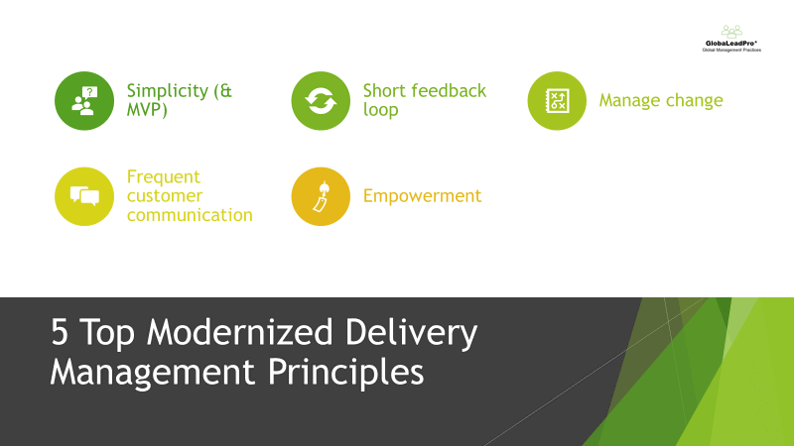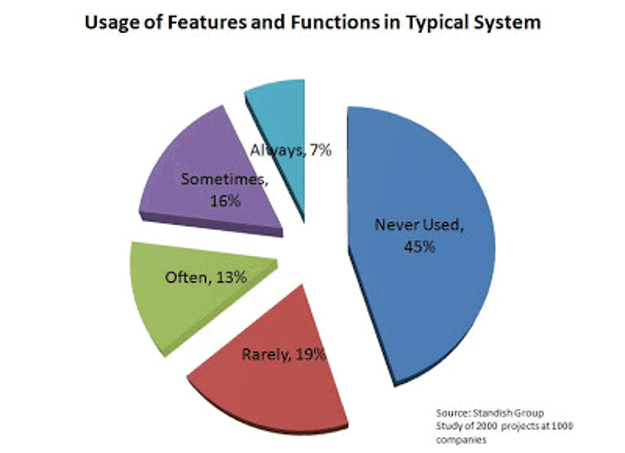Modernized Delivery – 5 top management principles

Agile methodologies and practices are now BAU in software development and management. They are also spreading into non-software projects and organizations as everyone looking for ways to do things faster and better.
At the same time, the understanding that way above a practice Agile is a concept and culture is growing, and organizations are looking for the next level above implementing scrum teams and sprints – changing culture and behaviors, changing processes from the foundations.
This is where modernized delivery comes in. It takes the concept and principles of agile and bring it to a broader context, with emphasize on the principles that should be implemented in today’s world in order to succeed.
So what are the most important Modernized Delivery principles for managers to adopt?
Simplicity (& MVP)
This is a real shift of mind set which changes reality. Thinking of the minimum solution, with the maximum business value is a real game changer. Understanding that it is OK to start simple (and keep simple) and add value as we go along, can totally transform organizations from slow and heavy to fast and nimble. (Statistics show that 64% of developed features are never or rarely used (according to Standish's research and more recent estimates)).

Short feedback loop
Short feedback loop means not only working in short iterations but also delivering a product at the end of them, such product that enables feedback from your customer.
This, above the solid progress indication and alignment it creates, is also a major enabler for an innovative environment. It increases the openness to failures as they are fast and correctable. At the same time, interim deliverables are the best measurement for progress and quality along the way, and therefor ensure also better quality and better results at the end.
Manage change
Expect change, prepare for it, and allow it.
It is pretty much impossible to be successful in projects today without allowing changes.
There are two aspects to this:
- The first one is the practice that is used. Obviously when working agile – short cycles and backlog grooming would result in more flexibility. But even if not working agile, knowing how to plan long term on one hand, and still keep flexibility for changes is a key. It is about making your plans focus on the big rocks and leave detailed planning for real time.
- The second aspect is of course the set of mind. Once we understand and accept the fact that change is a must, the next step is pretty operative - judging it per business value and priority, and making the right decisions/recommendations to your customers.
Frequent customer communication
There are two good things (at least) that happen when the communication with the customer is very frequent and close. First is the Project team better understand the vision, the needs, the debates and why decisions are made and is much more connected to the mission. At the same time there is no need to take assumptions, the right information is right there.
Second is that the customer understands much better the trade offs and the options and appreciates the related efforts much better. The end result is probably the biggest benefit – alignment. No (or very minimal) surprises. No blames. Obviously, this takes organizations to a new level of performance and so much time is saved on rework and waste.
Empowerment
Last but not least, this is an important principle that is here to stay. The best and most effective way to motivate teams and individuals and to create an X factor. Give teams the meaning, the ability to express themselves, the autonomy they need to create and the influence they need to make a difference – and they will. In today’s worlds with today’s challenges, having a motivated team that is eager and able to contribute is the needle mover.
And the real beauty of it? All of the above principles can be adopted and implemented immediately. It is totally up to a person and not depended at all on methodology, technology, or tools. Moreover, in many ways they are more effective than methodology technology and tools, as at the end it is the people that make the real difference.
And as we know, success in today’s world will rarely come with yesterday’s ways of working.
Thanks!
Want to talk to us?


